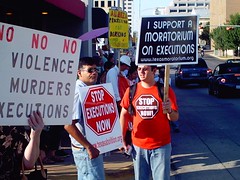August 24, 2006
Petition for Justice for Rodney Reed
CEDP has created an online petition for Rodney Reed.
From The Texas Observer
In April 1996, the body of Stacey Stites, a white, 20-year-old woman from Giddings, was found dumped in a field in Bastrop, southeast of Austin. A year after the crime, an extensive list of suspects was suddenly narrowed to oneRodney Reed, a 29-year-old black man from Bastrop. In less than 4 hours of deliberation, the all-white jury that heard the case convicted Reed of rape and murder, based on a single piece of DNA evidence found at the crime scene. Soon after, Reed was sentenced to death. Now, 10 years after the crime, Reed sits on death row, his case pending before the states highest criminal appeals court. A recently released documentary raises fresh questions about Reeds case and offers a detailed look at possible corruption in the small-town justice system that convicted him.
In October 2005, the Texas Court of Criminal Appeals remanded Reeds case to the state district court in Bastrop based on evidence of prosecutorial misconduct. In June, after hearing new evidence left out of the original trial, state District Judge Reva Towslee-Corbett ruled that Reeds attorneys failed to prove the new evidence could have changed the outcome of the trial. Reeds attorneys appealed the ruling, and the Court of Criminal Appeals is expected to take up Reeds case again this fall.
The newly released documentary, State vs. Reed, outlines evidence left out of the trial that clouds its outcome. The film was recently screened in Austin, with proceeds benefiting Reeds family. The film sheds light on the racially charged atmosphere surrounding the case: Reed is a black man accused of killing a white woman who was engaged to a white Bastrop police officer. Reed also claims he was having an affair with Stites during her engagement.
The affair could explain the one piece of DNA linking Reed to the crime scene: a small amount of sperm found in Stites body. The affair also gives motive to another possible suspect who largely escaped investigation, Stites fianc, Bastrop Police Officer Jimmy Fennell. My personal opinion when I heard that she had been killed was that Fennell did it, says former Bastrop prosecutor Steven Keng in the film. When we heard she had been having an affair with a black guy, it was like well, thats why he did it because… that would be a tremendous blow to his ego.
Reeds defenders continue to argue that the prosecution did not adequately investigate other possible suspects, including Fennell. Police officers never searched the apartment of Fennell and Stites, the last place she was known to have been. Fennell also twice failed a polygraph test when questioned about Stites death. Yet he was quickly eliminated as a suspect.
Fennells red pickup truck, which Stites reportedly took to work the morning she was killed, was found parked down the road from her body, leading investigators to suspect that she was transported in the truck. State investigators found only Stites and Fennells fingerprints in the truck.
In 2001, Reed found in his case file a previously unnoticed lab report filed by the state during his trial, which the prosecution failed to share with his defense team. The report states that DNA found on a beer can at the crime scene matched Stites and two Bastrop police officers. One of those police officers was Ed Samela, appointed lead detective for the case. 3 months after Samela began investigating the case, he was found dead from a gunshot wound to his head. The death was ruled suicide. None of this, however, has yet won Reed a new trial.
Prison system backs off change on death-row visits
Look what happens when you complain, as did a group of European anti-death penalty activists. Congratulations to Sandrine Ageorges, who had started a petition asking the prison to reverse itself. See you at the march in October, Sandrine!
From The Houston Chronicle, Aug 21:
State prison officials reversed course today on restricting death row visitors who have traveled more than 300 miles to 1 special 8-hour visit per trip.
Special visits, which consist of 2 4-hour sessions on consecutive days,are permitted once a month. But long-distance travellers who arrive late in a month will be allowed to “piggyback” a 2nd visit early in the next month, Texas Department of Criminal Justice spokeswoman Michelle Lyons said.
All such visits to the Polunksy Unit’s death row in Livingston will be at the warden’s discretion.
Lyons said TDCJ had made no systemwide policy change regarding long-distance visitors, but for about six weeks the warden at Polunsky had restricted special visits there to one per trip. That practice grew out of concern that some visitors, especially those from Europe, had abused department policy by establishing residences near the prison.
Lyons said prison officials will remain alert to signs that long-distance visitors have established residences in the area. Some had obtained local post office boxes and telephone numbers. At least one had planned to open a business.
Regular weekly visits consisting of 2-hour sessions are not affected.
Lyons said the earlier restrictions on multiple special visits had applied only to the Polunsky Unit.
The restriction on multiple visits had raised concerns among European death row activists, scores of whom visit condemned prisons in American prisons. Sandrine Ageorges, a French death penalty opponent, began circulating a petition opposing visiting restrictions.
Many foreign visitors, she said, could not afford to visit Texas for a single 8-hour visit. Shorter weekly visits, she contended, were insufficient to build rapport with inmates.
Texas prison authorities freedom fry French visitors to death row
A couple of months ago, we decided to set the date for the 7th Annual March to Stop Executions on Oct 28, the last weekend of the month, in order to accomodate our friends from Europe who wanted to attend the march and on the same trip make two visits during one trip to the U.S. to their friends on death row. Europeans have to fly more than 10,000 miles round-trip to visit death row. Now, TDCJ is nonsensically trying to limit the ability of people from Europe from visiting death row at the end of one month and again at the start of another month. In an attempt to get the rule changed back, the Europeans have started an online petition.
You have to wonder if TDCJ is acting on sound penological grounds or if they are acting out of petulance towards “foreigners” establishing relationships with people on death row that do not meet with the approval of conservative prison authorities. Texas policymakers have a long history of instituting rules that retaliate against people because of their private relationships. Most Europeans who visit people on death row are motivated to establish friendships with them because the death penalty is considered by most Europeans, and many Texans, as a crime against humanity. Visiting people under a sentence of death is a way for people of conscience to contribute a bit of humanity to the world. TDCJ should be greatful, because inmates who receive visitations are undoubtedly easier to manage. TDCJ seems to have changed its rules to retaliate against the Europeans’ support for people sentenced to death in Texas. The Texans at TDCJ are retaliating against the strongly held idea, prevalent in Europe, that every human being has worth, no matter what crimes a person may have committed. It is a difference of opinion, but it should not be the basis for changing a rule that contributes to maintaining order on death row.
TDCJ’s action brings to mind what happened in 2003 when the Republican-led U.S. Congress renamed french fries, which by the way originated in Belgium, to freedom fries in an act of petulance against France’s position on the war in Iraq. Just this year, the policy on Freedom Fries was reversed and French Fries are again served in the congressional cafeteria. The US politician who led the campaign to change the name of french fries to “freedom fries” has turned against the war, saying “If we were given misinformation intentionally by people in this administration, to commit the authority to send boys, and in some instances girls, to go into Iraq, that is wrong.”
We can only hope that the people who instituted the new anti-European visitation rules will come to their senses and change the rule back to what it was.
Below is information reported in The Houston Chronicle:
“the Texas Department of Criminal Justice has rolled up the welcome mat for prison visitors…who must travel long distances to the state’s far-flung prisons. TDCJ’s recently implemented action limits European visitors — or anyone who has traveled more than 300 miles — to one “special visit” per trip. The special visit consists of two four-hour sessions scheduled on consecutive days. Regular weekly visits, consisting of two-hour sessions, are not affected by the change.
Some European visitors, irate that they will be limited to one eight-hour visit per trip to the United States, have launched a petition calling on the state agency to reconsider.
“Most visitors,” Sandrine Ageorges said in an e-mail from her home in France, “can only afford to stay a week or so. Two special visits, when one visits at the end of a month back to back with another (early monthly visit) makes the trip, the expense and the time really worthwhile to all concerned.”
Ageorges, who noted that she has advocated for Texas death row inmates for 10 years, typically visits the United States four times a year, sometimes staying a month.
She is one of scores of European death penalty opponents, some of whom have married inmates by proxy, who journey to the United States to visit condemned prisoners. European capital-punishment foes and media are especially drawn to Texas, whose execution of 373 inmates since the punishment was resumed in 1982 has made it notorious in activist circles.
Ageorges said the regular two-hour weekly visits are less than satisfactory because “two hours is about the time a segregated prisoner needs to adjust to a visitor.”
“A regular visit in itself is very short when you consider that most overseas visitors make at least a 10,000-mile round trip to come for a visit,” Ageorges said, adding that she has made the journey for a single two-hour visit with an inmate.
“This recent modification to the special visitation rule (done very quietly by the warden) is probably one too many for all death row visitors and for the prisoners,” she wrote. “Our longtime fears are taking shape and we cannot sit there and let it happen.”
Starting to plan for 7th Annual March to Stop Executions

Next Monday (8/21), we are going to start planning the 7th Annual March to Stop Executions on Oct 28 in Austin. If you are in Austin, you can come by the weekly CEDP meeting next Monday where one item on the agenda will be the first planning discussion about the march. The meeting is August 21 on the UT campus at 7pm in Pearce Hall, Room 2.404 on the ground floor.
Here is a news story on last year’s march. It contains a link to a video on the march. Another news story.
If you can’t make the meeting, you can always send ideas and other comments about this year’s march to the maustin list. Something we will be deciding next week is the start and end places for the march, so if you liked last year’s start at City Hall, let us know, of if you prefer Republic Park, as in past years, let us know that too.
Also, did you like ending up opposite the governor’s mansion, like last year, or would you prefer other places, like the court of criminal appeals, where we have had ended it a couple of times, or the south steps of the capitol, or somewhere else?
As always, we look forward to working with everyone on the march, to seeing lots of people in the movement together again in Austin and to making a lot of noise at this year’s march. Maybe we can focus attention on the three cases of probable wrongful executions that have been in the news a lot since last year’s march.
By the day of the march, we will have heard back from the Tides Foundation about whether they are going to approve the grant application that we just submitted to them for $50,000 as a joint application from the anti-death penalty groups that have worked together on the march all these years, CEDP, TMN, TDPAM, TCADP, TSADP and Victims of Texas. Representatives from each of those organizations held a series of meetings over the past six weeks to write the grant. The grant was for a campaign to win a moratorium on executions in Texas by 2009. In the application, we wrote that “our campaign features a program of statewide education, organizing, and networking events to be conducted throughout the year. We will engage in systematic outreach and grassroots organizing designed to persuade the Texas legislature of the need for a moratorium on executions and the creation of a commission to study the death penalty”.
If the grant is approved, then 2007 is going to see some major strides in anti-death penalty organizing in Texas. We are optimistic that the grant will be approved. After all, you would think they would jump at the opportunity to fund a serious campaign against the death penalty in the one state where the most executions take place, but you never know. We expect to hear back from Tides by mid-October.
- Texas Moratorium Network (TMN) is a non-profit organization with the primary goal of mobilizing statewide support for a moratorium on executions in Texas. Significant death penalty reform in Texas, including a moratorium on executions, is a viable goal if the public is educated on the death penalty system and is encouraged to contact their elected representatives to urge passage of moratorium legislation.
We hope that you will join us in this fight for fairness and social justice.Please join our email list and become one of the more than 20,000 people receiving information through our network.











